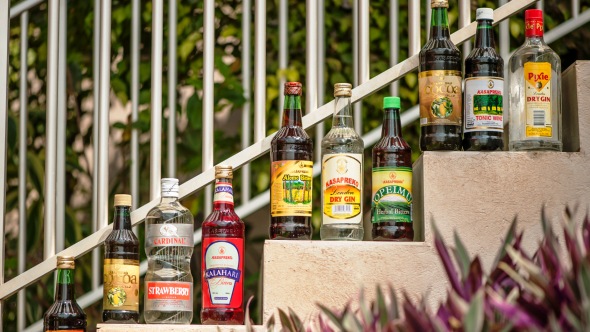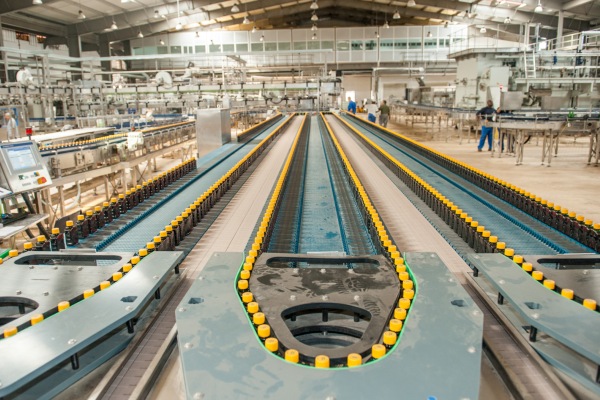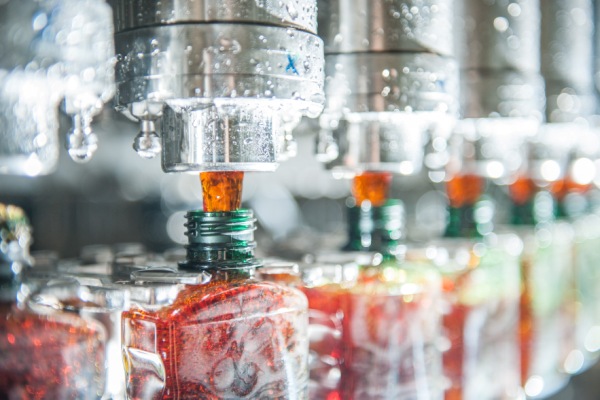Kasapreko | Ghana Beverage Industry
Kasapreko is launching another export campaign. The company had already begun exporting to South Africa and Tanzania in 2012. In 2013 Kasapreko aims to be selling its products in East Africa as well, with Kenya, Tanzania, Uganda, Ruanda and Burundi, a market with 210 million people.

Container: convex at the front, concave at the back
“We sent inquiries to machinery manufacturers in Italy, America, India, China and Germany, and checked out plenty of different factors”, explains Dr. Kwabena Adjei. “The sturdiness of the machines, the after-sales service and an efficiency-driven technology were our principal concerns. We knew then what we wanted, but we didn’t have any experience with the new technology. Together with our consultant Leslie Banks-Irvine, we opted for Krones. Originally, we had planned for two 24,000-bph lines, but as we talked to Krones we realised that actually we were looking at a higher output. It was only that we weren’t sure whether such a line rating was in fact possible with the small 200-millilitre PET bottles.”
Our most important sales market at present remains West Africa, where we still have a lot to do. Besides tapping into the markets of South Africa and West Africa, we’ve long since had a presence among the Ghanaian and Nigerian communities in the global diaspora, not only in Europe, but also in the USA and in Asia.
The PET container is concave at the front and convex at the back, which means it can be packed with optimum space-economy. The design had already won an award for successful packaging beforehand. Since the front and back are different in design, it’s essential to orientate the bottles during labelling to ensure that in actual fact only the front is labelled. “It’s rather tricky to meet the technological stipulations involved at this high speed. But the Krones layout team did a brilliant job”, says an appreciative Dr. Kwabena Adjei. “Krones also delivered the kit on time, though unfortunately there were some delays in building the new hall.”
Knowledge transfer has paid off
Installation of the line finally began on 15 July 2012, with the kit being transported in 60 containers (and the big machines separately) from the nearby harbour. Both lines started operation early in December 2012. “This was made possible by excellent cooperation between the Krones staff, the subsuppliers and our own team”, comments Dr. Kwabena Adjei. Kasapreko had beforehand sent 14 of its people for two to four weeks each to the Krones Academy in Germany, in order to create the requisite knowledge transfer. “That really paid off. A high-speed line is simply a very complex system, which you have to know how to handle”, he adds.
Weighing-cell filler with a very low standard deviation in the PET line

The high-speed PET line is supplied with containers by a Contiform S24 blow-moulding machine, which is set up for transparent, flat 0.2-litre, blue 0.5-litre, plus round 0.75-litre containers of green and blue material. An AirCo conveyor feeds them to the rinser-filler monobloc, which features a gravimetric filler in the shape of a Sensometic VP-GW-PET. “Mainly, we wanted a filler that ensures very accurate fill levels”, says Dr. Kwabena Adjei. “If we overfill the bottles, it means we’re giving away money, while if we underfill them we’re cheating the customers.” It’s this reassuring certainty of a precise fill level that the weighing-cell filler with neck-handling offers, thanks to its very low standard deviation. The fill level is then also verified by a Checkmat F-G. Via a generously dimensioned buffer table, which ensures the requisite time buffering, the containers are passed to the Solomatic labeller, which dresses the containers at the shoulder using a cold-glue station. A Linaglide then distributes the containers among up to six lanes. At the same time, two Variocart carton erectors unfold the carton blanks. In a Linapac II, the cartons and the bottles are then brought together, whereupon the cartons are sealed by a Variocol, and palletised by a Modulpal 2AC.
Vacuum filler in the glass line
The same type of palletiser is directly adjacent, and is tasked with palletising the glass bottles from the glass line: here, the returnable glass is fed into the line by hand. For bulk glass, Kasapreko has installed a Pressant sweep-off depalletiser, which pushes the bottles directly onto the conveyor in the filling level about seven metres higher. A Glideliner spaces out the bottles for cleaning in a Lavatec KES single-end washer. The washed containers are monitored by a Linatronic empty-bottle inspector before they are filled by an Sensometic VV-CIP. A vacuum filler with a standard deviation of ±1.5 millimetres was chosen for filling the 0.75-litre bottles. Here, too, the fill level is inspected by a Checkmat F-G. The bottled are dressed by a Starmatic labeller. End-of-the-line packaging is similar in conception to that in the PET line, with a Variocart erecting the cartons, a Smartpac inserting the bottles, and the packs then being sealed by a Variocol.
Affordable products

“In the African consumer market, it’s the three “A”s that rule: availability, affordability, accessibility“, to quote Dr. Kwabena Adjei. The consumer prices for Alomo Bitters are approximately two US-dollars for the 200-millilitre flat bottles, and about five US-dollars for the 0.75-litre bottle. “That’s very affordable. Which is why the efficiency of the bottling lines is so important, so that the product remains affordable, and we can nonetheless make a profit. And for this we need the very best technology. For the PET containers, too, every gram of weight we save is precious in terms of material-economy.”
Jump onto the global market
Now that the two lines have been commissioned, Kasapreko is launching another export campaign. The company had already begun exporting to South Africa and Tanzania in 2012. In 2013 Kasapreko aims to be selling its products in East Africa as well, with Kenya, Tanzania, Uganda, Ruanda and Burundi, a market with 210 million people.
“Our most important sales market at present remains West Africa, where we still have a lot to do. Besides tapping into the markets of South Africa and West Africa, we’ve long since had a presence among the Ghanaian and Nigerian communities in the global diaspora, not only in Europe, but also in the USA and in Asia”, explains Dr. Kwabena Adjei. And underlines the firm’s declared objective: “In five years’ time, we aim to be an internationally respected spirits producer on the global market.” The first step has been taken.